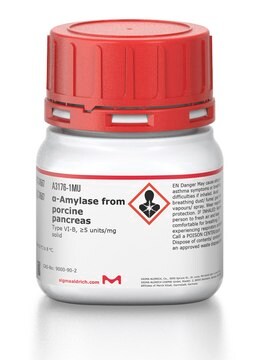V900486
Pancreatin from porcine pancreas
Vetec™, reagent grade
Synonym(s):
Pancreatin from hog pancreas
Sign Into View Organizational & Contract Pricing
All Photos(2)
About This Item
Recommended Products
grade
reagent grade
product line
Vetec™
form
powder
storage temp.
−20°C
Looking for similar products? Visit Product Comparison Guide
Biochem/physiol Actions
Pancreatin contains enzymatic components including trypsin, amylase and lipase, ribonuclease, and protease, produced by the exocrine cells of the porcine pancreas. This combination of enzymes allows it to hydrolyze proteins, starch and fats. Pancreatin will convert not less than 25 times its weight of potato starch into soluble carbohydrates in 5 minutes in water at 40°C, will digest not less than 25 times its weight of casein in 60 minutes at pH 7.5 at 40°C and will release not less than microequivalents of acid per min per mg pancreatin from olive oil at pH 9.0 at 37°C.
Legal Information
Vetec is a trademark of Merck KGaA, Darmstadt, Germany
Signal Word
Danger
Hazard Statements
Precautionary Statements
Hazard Classifications
Eye Irrit. 2 - Resp. Sens. 1 - Skin Irrit. 2 - Skin Sens. 1 - STOT SE 3
Target Organs
Respiratory system
Storage Class Code
11 - Combustible Solids
WGK
WGK 1
Flash Point(F)
Not applicable
Flash Point(C)
Not applicable
Choose from one of the most recent versions:
Certificates of Analysis (COA)
Lot/Batch Number
Don't see the Right Version?
If you require a particular version, you can look up a specific certificate by the Lot or Batch number.
Already Own This Product?
Find documentation for the products that you have recently purchased in the Document Library.
Jaroslaw Czubinski et al.
Journal of agricultural and food chemistry, 60(7), 1830-1836 (2012-01-24)
Lupin seed globulin proteins form complexes with flavonoids, predominantly apigenin C-glycosides. Enzymes typical for the gastrointestinal tract were used to hydrolyze lupin seed globulins. Release of native flavonoids as a result of the proteolysis reaction was observed. Different analytical methods
Fady Ibrahim et al.
European journal of pharmaceutical sciences : official journal of the European Federation for Pharmaceutical Sciences, 46(5), 323-328 (2012-03-01)
The purpose of this study was to investigate the intraluminal processing of novel oral lipid-based formulations of amphotericin B using an in vitro lipolysis model. Amphotericin B (AmB) was formulated in three lipid-based formulations consisting of different lipid components: iCo-009
Silvia Mazzaferro et al.
Journal of controlled release : official journal of the Controlled Release Society, 162(3), 568-574 (2012-08-21)
In this study we investigated the potential of mucoadhesive nanoparticles to enhance the intestinal permeability of docetaxel (Dtx). These nanoparticles were composed of methyl-β-cyclodextrin (Me-β-CD) combined with poly(isobutylcyanoacrylate) and coated with thiolated chitosan. In order to encapsulate the highest amount
Shufen Wu et al.
Food chemistry, 141(3), 2944-2951 (2013-07-23)
Three bioactive peptides, angiotensin-converting enzyme-inhibitory peptides (ACEIPs), casein phosphopeptides (CPPs) and antimicrobial peptides (AMPs), were simultaneously prepared from casein by pancreatic hydrolysis via an enzymatic membrane reactor (EMR) and combinational chromatography. The reaction was performed at 37 °C and pH
K E Aarak et al.
The British journal of nutrition, 110(8), 1402-1410 (2013-03-21)
In the present study, we hypothesised whether in vitro digestion of salmon oil would release different amounts of PUFA depending on the origin of the lipolytic enzymes used. For this purpose, in vitro digestion of salmon oil (SO) was performed
Our team of scientists has experience in all areas of research including Life Science, Material Science, Chemical Synthesis, Chromatography, Analytical and many others.
Contact Technical Service









